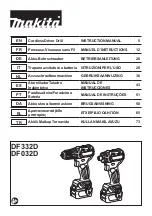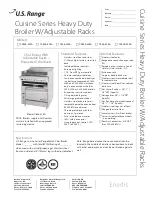
5
OPERATING INSTRUCTIONS
WARNING:
To reduce the risk of serious personal injury, read, understand and follow
all important safety warnings and instructions prior to using tool.
Switch
To turn the drill ON squeeze the trigger switch. The farther the trigger is depressed, the
higher the speed of the drill. To turn the tool OFF release the trigger switch.
The drill can be locked ON (maximum RPM only) for continuous use by squeezing the
trigger while pushing up on the locking button (Fig .1)
.
Hold the locking button up while you
release the trigger switch and then release the locking button. The drill will continue to run.
To turn the drill OFF from a locked ON condition, squeeze and release the trigger
WARNING:
The drill should only be locked ON when it is held stationary in a drill
press stand or other means; NOT BY HAND! Never unplug the tool with the locking feature
engaged. To do so will cause the tool to start immediately the next time it is plugged in.
REVERSING
With the trigger switch released, slide the reversing switch, (Fig. 2) to align with the arrow
pointing forward for drilling or toward the arrow pointing backward for running in reverse.
After all reversing operations, switch the tool to the forward running mode.
NOTE:
WHEN THE REVERSING SWITCH IS IN NEUTRAL THE DRILL WILL NOT
OPERATE. DO NOT FORCE TRIGGER. SELECT FORWARD OR REVERSE BEFORE
TURNING DRILL ON.
KEYLESS CHUCK OPERATION
This tool is equipped with a feature that automatically locks the spindle when the tool is not
running. This feature is a normal condition which allows for tightening or loosening of the
chuck with one hand while holding the drill with the other. Loosen the chuck by rotating the
sleeve counterclockwise (Fig. 3). Insert the bit or other accessory fully into the chuck, and
tighten securely by rotating the sleeve in the clockwise direction as viewed from the chuck
end.
Drilling
• Always unplug the drill when attaching or removing accessories. When using a keyless
chuck, hand tighten firmly.
• Use sharp drill bits only.
• Support and secure work properly, as instructed in the Safety Instructions.
• Use appropriate and required safety equipment, as instructed in the safety instructions.
• Secure and maintain work area, as instructed in the safety instructions.
• Run the drill very slowly, using light pressure, until the hole is started enough to keep the
drill bit from slipping out of it.
• Apply pressure in a straight line with the bit. Use enough pressure to keep the bit biting
but not so much as to stall the motor or deflect the bit.
• Hold the drill firmly to control its twisting action.
• DO NOT CLICK THE TRIGGER OF A STALLED DRILL OFF AND ON IN AN ATTEMPT
TO START IT. DAMAGE TO THE DRILL CAN RESULT.
• Minimize stalling on breakthrough by reducing pressure and slowly drilling through the
last part of the hole.
• Keep the motor running while pulling the bit out of a drilled hole This will help reduce
jamming.
• Use a cutting lubricant when drilling metals. The exceptions are cast iron and brass which
should be drilled dry. The lubricants that work best are sulphurized cutting oil or lard oil.
Bacon grease will also serve.
• When using twist drill bits to drill holes in wood, it will be necessary to pull the bits out
frequently to clear chips from the flutes.
• Plug in drill.
Make sure switch turns drill on and off.
WARNING:
It is important to support the work properly and to hold the drill firmly to
prevent loss of control which could cause personal injury If you have any questions on how
to properly operate tool, call: 1-800-544-6986
MAINTENANCE
Use only mild soap and damp cloth to clean the tool. Never let any liquid get inside the
tool; never immerse any part of the tool into a liquid.
IMPORTANT:
To assure product SAFETY and RELIABILITY, repairs, maintenance and
adjustment should be performed by authorized service centers or other qualified service
organizations, always using identical replacement parts.






































